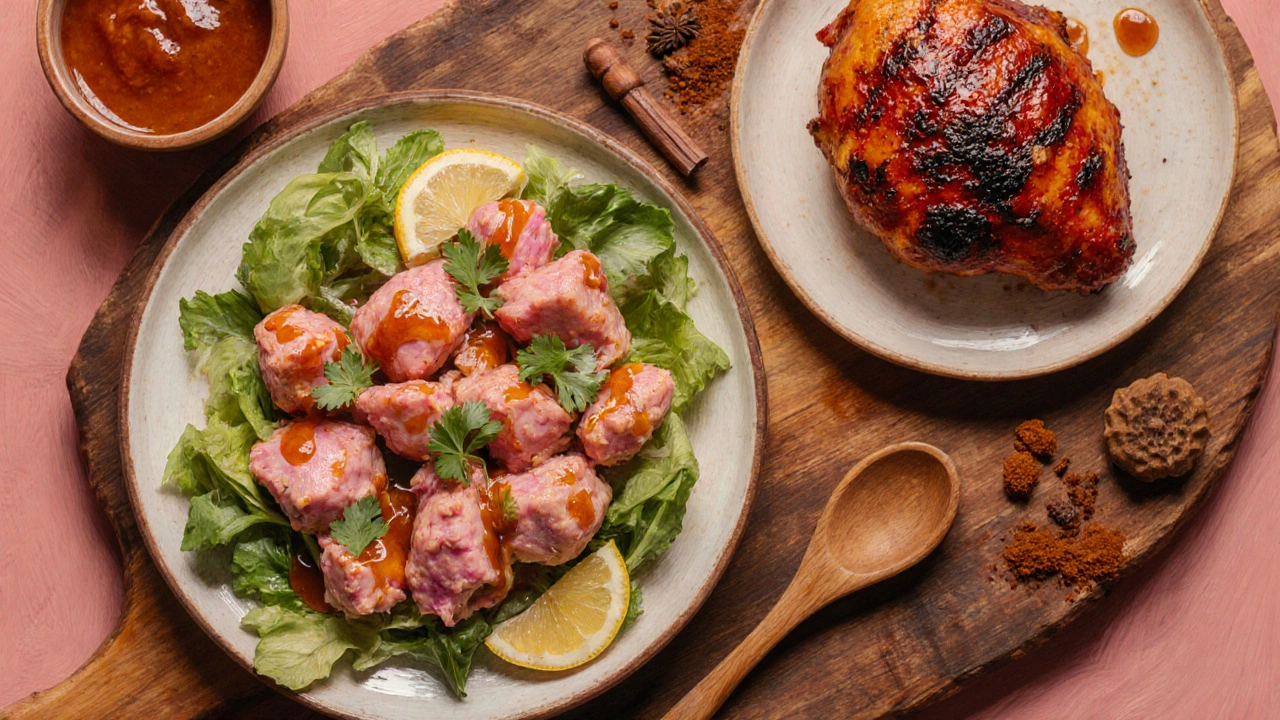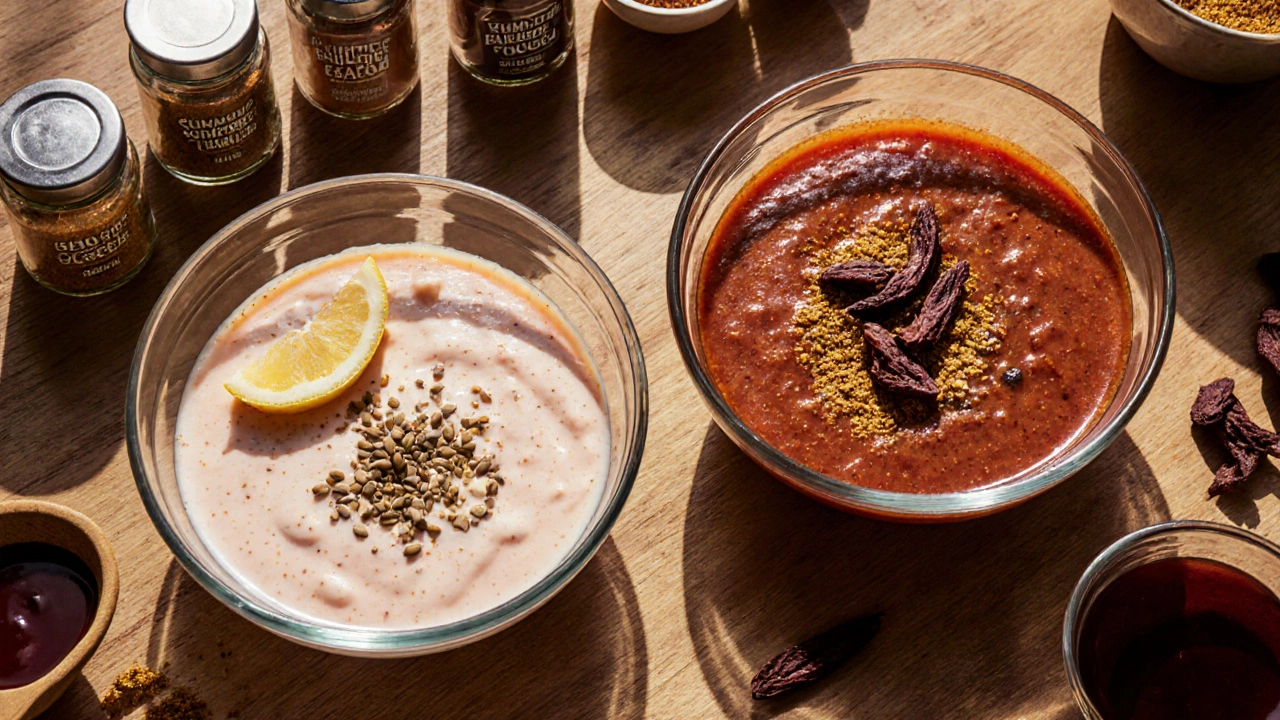9 Oct 2025
- 0 Comments
Tikka vs Tandoori Sauce Selector
Recommended Sauce
Key Ingredients:
Best For:
When you glance at a menu and see "tikka" or "tandoori" beside a dish, you might wonder what the sauce does for the flavor. Both sauces are staples of North Indian cooking, but they aren’t interchangeable. This article breaks down the tikka sauce and tandoori sauce, highlights the flavor, ingredient, and technique gaps, and gives you a quick way to decide which one belongs in your kitchen.
Key Takeaways
- Tikka sauce is yogurt‑based, thinner, and meant for quick marination.
- Tandoori sauce is thicker, oil‑rich, and designed for high‑heat cooking in a tandoor.
- The spice blends overlap, but tandoori leans heavier on smoked paprika and dried chilies.
- Both sauces can be adapted for veg and non‑veg dishes, but timing and heat differ.
- Making them at home lets you control salt, heat, and consistency.
What is Tikka Sauce?
Tikka sauce is a smooth, yogurt‑based mixture that blends dairy with mild spices to create a tangy, creamy coating. It typically contains plain or Greek yogurt, a splash of lemon juice, ginger‑garlic paste, and a light spice blend featuring cumin, coriander, and a pinch of chili powder. The yogurt’s acidity gently tenderizes meat or vegetables while keeping the final dish moist.
Because the base is dairy, the sauce stays relatively cool; chefs often marinate chicken, paneer, or vegetables for 30minutes to 4hours before grilling or pan‑frying. The result is a subtly spiced, pink‑tinged bite that highlights the main ingredient’s texture.
What is Tandoori Sauce?
Tandoori sauce is a thick, oil‑laden paste that combines yogurt with a deeper, smoky spice blend suited for high‑heat cooking. In addition to yogurt, it incorporates mustard oil or vegetable oil, ground dried red chilies, smoked paprika, and a heavier dash of garam masala. The added oil raises the sauce’s smoke point, making it ideal for the blistering temperatures of a tandoor oven.
Traditional tandoori chicken is marinated for at least 6hours, often overnight, allowing the spices to penetrate fully. When the meat hits the scorching heat of the tandoor (around 480°F/250°C), the oil helps develop a charred, caramelized crust while keeping the interior juicy.

Core Ingredients Side‑by‑Side
- Base: Both start with yogurt, but tandoori adds oil for richness.
- Acidity: Lemon juice is common in tikka; tandoori often relies on the yogurt’s natural tang.
- Spice Mix: Tikka uses cumin, coriander, turmeric, and mild chili; tandoori layers garam masala, smoked paprika, and dried red chilies for heat.
- Color: Tikka gets a pale pink from food coloring or beet; tandoori is deeper red from chili powder and paprika.
- Consistency: Tikka is pourable, perfect for brushing; tandoori is thicker, clings to meat during high‑heat cooking.
Flavor Profile & Heat
If you taste a spoonful of tikka sauce, expect a cool, tangy bite with a whisper of spice. The yogurt’s creaminess softens any heat, making it suitable for families with milder palates. Tandoori sauce, by contrast, delivers a robust, smoky heat that lingers on the tongue. The oil and dried chilies amplify the spice, while the garam masala adds depth with notes of cardamom, cloves, and cinnamon.
Cooking Method & Typical Uses
Tikka is usually applied to quick‑grill items like paneer tikka, chicken tikka skewers, or vegetable bites that cook in 10‑15minutes on a grill or stovetop pan.
Tandoori thrives in the traditional tandoor oven. The intense dry heat creates a signature char and the sauce’s thick texture prevents it from running off the meat. If you don’t have a tandoor, a very hot oven (450°F/230°C) or a charcoal grill can mimic the effect.
Both sauces can be repurposed: drizzle tikka over a salad, mix tandoori into a stir‑fry, or use the leftovers as a base for a curry.
DIY Basics - Simple Recipes
- Gather 1 cup plain yogurt, 2tbsp lemon juice, 1tbsp grated ginger, 1tbsp minced garlic.
- For tikka: add 1tsp cumin, 1tsp coriander, ½tsp turmeric, ¼tsp chili powder, a pinch of salt.
- For tandoori: add 2tbsp mustard oil, 2tsp smoked paprika, 1tsp dried red chili powder, 1tsp garam masala, a pinch of salt.
- Whisk until smooth. Taste and adjust acidity or heat.
- Marinate your protein or veg for the recommended time (30min for tikka, 6hr+ for tandoori).
- Cook over high heat, baste with extra sauce if needed.
This basic framework lets you swap ingredients based on dietary needs - use coconut yogurt for dairy‑free tikka or replace mustard oil with olive oil for a lighter tandoori version.

Common Mistakes & Pro Tips
- Over‑diluting: Adding too much yogurt makes the sauce runny, preventing it from sticking during grilling.
- Skipping the oil in tandoori: Without oil, the sauce burns quickly and the meat dries out.
- Under‑marinating: Tikka can be ready in an hour, but tandoori needs long rest to let the spices penetrate.
- Using low‑fat yogurt: Fat carries flavor; choose full‑fat or Greek yogurt for richer taste.
- Forget the food coloring: If you want that iconic pink hue for tikka, a few drops of beet juice or natural pink food dye do the trick.
Pro chefs also add a splash of honey to tandoori sauce for a subtle caramelization on the crust.
Side‑by‑Side Comparison Table
| Attribute | Tikka Sauce | Tandoori Sauce |
|---|---|---|
| Base | Full‑fat yogurt | Yogurt + oil (mustard/vegetable) |
| Typical Spice Blend | Cumin, coriander, turmeric, mild chili | Garam masala, smoked paprika, dried chilies, chili powder |
| Consistency | Pourable, thin | Thick, paste‑like |
| Heat Level | Low to medium | Medium to high |
| Marination Time | 30min - 4hr | 6hr - overnight |
| Cooking Method | Grill, pan‑fry, broil | Tandoor, very hot oven, charcoal grill |
| Typical Dishes | Chicken tikka, paneer tikka, veg skewers | Tandoori chicken, tandoori fish, tandoori lamb |
| Color | Pale pink (optional food coloring) | Deep red/orange |
When to Choose Which Sauce
If you’re planning a quick weeknight grill, reach for tikka sauce - its thin texture spreads easily, and a short marination keeps dinner on the table fast.
Planning a weekend feast with a charcoal BBQ or a home tandoor? Load up on tandoori sauce, let the meat soak overnight, and enjoy that signature charred edge.
Vegetarians can swap chicken for cauliflower or mushroom; the sauce choice still dictates the final flavor intensity.
Frequently Asked Questions
Can I use tikka sauce for tandoori chicken?
You can, but the result will be milder and less charred. Tikka lacks the oil and smoked spices that create the classic tandoori crust.
Is the oil in tandoori sauce necessary?
Yes. The oil raises the smoke point, helps the sauce adhere during the extreme heat of a tandoor, and adds richness to the final bite.
Can I substitute Greek yogurt with coconut yogurt?
For tikka sauce, coconut yogurt works well and keeps it dairy‑free, though the flavor will be slightly sweeter. In tandoori sauce, the lower fat content may affect the caramelization, so add a bit more oil.
How long can I store homemade sauces?
Refrigerated in an airtight container, both sauces last about 5‑7days. For longer storage, freeze in portions for up to 3months.
What’s the secret to that pink tikka color?
A few drops of beet juice, natural pink food dye, or a pinch of pink paprika will give the sauce that signature hue without altering the taste.
